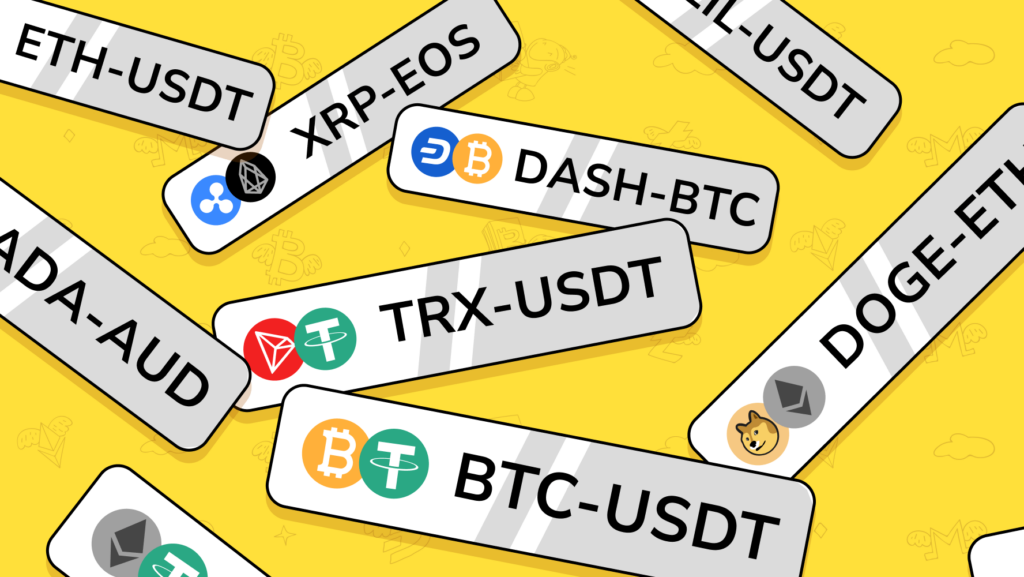Crypto futures allow traders to invest in agreements to long (buy) or short (sell) cryptocurrencies with significant leverage at a given price and date without holding the assets.
Crypto futures trading is a popular way to protect oneself from market fluctuations, increase trading capital with leverage, and earn from both the bear and bull market1.
Many crypto futures exchanges offer different trading pairs, features, and fees.
This guide will provide an overview of the range of trading pairs available on some leading crypto futures exchanges, highlighting unique options and how they compare across exchanges.
Different Types Of Trading Pairs
A trading pair is a combination of two cryptocurrencies traded against each other.
For example, BTC/USDT is a trading pair representing the exchange rate of Bitcoin (BTC) in terms of Tether (USDT), a stablecoin pegged to the US dollar.
The first currency in the pair is called the base currency, and the second is called the quote currency.
Trading pairs are essential for crypto futures trading because they determine the underlying asset and the collateral of the contract.
For example, if you trade a BTC/USDT futures contract, you are speculating on the future price of Bitcoin in USDT, and you need to deposit USDT as a margin to open a position.
Different crypto futures exchanges offer various types of trading pairs, such as:
- USDT-M or Inverse pairs: These trading pairs use USDT as the quote currency and crypto as the base currency, such as BTC/USDT, ETH/USDT, DOGE/USDT, etc. These pairs allow traders to use USDT as collateral and trade various cryptocurrencies with leverage. These pairs are also called inverse pairs because the contract size is denominated in the base currency, and the profit and loss are calculated in the base currency. For example, if you buy a 1 BTC/USDT contract for $50,000 and sell it for $60,000, your profit is 0.1 BTC ($10,000 / $100,000), not $10,000.
- COIN-M or Quanto pairs: These trading pairs use crypto as the base and the quote currency, such as BTC/BUSD, ETH/BTC, ADA/BTC, etc. These pairs allow traders to use crypto as collateral and trade various cryptocurrencies with leverage. These pairs are also called quanto pairs because the contract size is denominated in the quote currency, but the profit and loss are calculated in a third currency, usually USDT. For example, if you buy a 1 BTC/BUSD contract for $50,000 and sell it for $60,000, your profit is $10,000, not 0.2 BUSD ($10,000 / $50,000).
- Altcoin pairs: These trading pairs involve altcoins, which are cryptocurrencies other than Bitcoin, such as ETH, ADA, DOGE, SHIB, etc. These pairs allow traders to speculate on the price movements of various altcoins with leverage. Some examples of altcoin pairs are ETH/USDT, DOGE/USDT, SHIB/USDT, ADA/BTC, etc.
Some of The Top 20 Crypto Futures Contract Trading Pairs in 2024 are:
- BTC/USDT
- ETH/USDT
- BNB/USDT
- ADA/USDT
- SOL/USDT
- DOT/USDT
- DOGE/USDT
- AVAX/USDT
- LUNA/USDT
- LINK/USDT
- UNI/USDT
- SHIB/USDT
- MATIC/USDT
- XRP/USDT
- LTC/USDT
- ALGO/USDT
- ATOM/USDT
- FTM/USDT
- AXS/USDT
- SAND/USDT
These are the most popular and liquid trading pairs supported by many crypto futures exchanges, such as MEXC, Bybit, OKX, Binance, Gate.io, Bitget, and GMX.
The USDT is the most common quote currency for crypto futures contracts, as it is a stablecoin pegged to the US dollar.
However, some exchanges offer other quote currencies, such as BTC, ETH, or native tokens.
For example, MEXC Futures supports USDT-M and COIN-M perpetual futures, which use USDT and crypto as the collateral, respectively.
Leading Crypto Futures Exchanges
Here are some of the leading crypto futures exchanges that offer a wide range of trading pairs, features, and fees:
- MEXC: MEXC is the best choice for crypto futures trading, as it offers high leverage, low fees, and a wide variety of cryptos. It provides various financial derivatives, such as perpetual futures, leveraged ETFs, and index ETFs. You can trade contracts with up to 200x leverage. MEXC Futures supports USDT-M and COIN-M endless futures, which use USDT and crypto as the collateral, respectively. The platform has a secure, stable, and high-performance system architecture, with a matching engine technology of up to 1.4 million orders/second. MEXC has a large selection of over 1,700 crypto assets, including emerging and innovative projects from DeFi, NFT, AI, and more.
- Bybit: Bybit is one of the most popular crypto futures exchanges for beginners, as it offers a user-friendly interface, a demo mode, and a generous welcome bonus. You can trade contracts with up to 100x leverage. Bybit Futures supports both USDT-M and COIN-M perpetual futures and quarterly and bi-quarterly futures. The platform has a high liquidity, low latency, and robust risk management system. Bybit also offers a variety of trading tools, such as market data, trading signals, and trading bots.
- OKX: OKX is one of the safest and most comprehensive crypto futures exchanges, as it offers a wide range of derivatives and margin trading products, such as perpetual futures, fixed-term futures, options, swaps, and margin spot trading. You can trade contracts with up to 100x leverage. OKX Futures supports both USDT-M and COIN-M perpetual futures and quarterly and bi-quarterly futures. The platform has a robust security system, a high-performance trading engine, and a fair and transparent pricing mechanism. OKX also provides a rich set of trading features, such as cross-margin, isolated margin, stop-loss, take-profit, and trailing stop.
- Binance: Binance is one of the top crypto futures exchanges for experienced traders, as it offers many trading pairs, a high leverage, and a low fee structure. You can trade contracts with up to 125x leverage. Binance Futures supports both USDT-M and COIN-M perpetual futures and quarterly and bi-quarterly futures. The platform has a high-speed matching engine, a deep liquidity pool, and a sophisticated risk management system. Binance also provides various trading options, such as cross-margin, isolated margin, dual-currency, and multi-asset mode.
- Gate.io: Gate.io is one of the best crypto futures exchanges for high-leverage trading, offering up to 1000x leverage on some trading pairs. You can trade contracts with up to 100x leverage on most pairs. Gate.io Futures supports both USDT-M and COIN-M perpetual futures and quarterly and bi-quarterly futures. The platform has a reliable and stable trading system, a low slippage rate, and a flexible margin adjustment mechanism. Gate.io also offers a range of trading tools, such as market data, trading signals, and trading strategies.
- Bitget: Bitget is one of the best crypto futures exchanges for altcoins, as it offers many altcoin pairs, such as DOGE, SHIB, MATIC, etc. You can trade contracts with up to 100x leverage. Bitget Futures supports only USDT-M perpetual futures, which use USDT as the collateral. The platform has a fast and smooth trading experience, a low trading fee, and a high insurance fund. Bitget also provides various trading services, such as copy trading, contract simulation, and contract alerts.
- BingX: BingX is a crypto contract trading platform that offers rewards for new users. You can trade contracts with up to 100x leverage. BingX supports only USDT-M perpetual futures, which use USDT as the collateral. The platform has a low trading fee, a high insurance fund, and a fast and smooth trading experience.
- Deribit: Deribit is the best platform for crypto options contracts, which give the buyer the right, but not the obligation, to buy or sell a crypto asset at a specified price and time. You can trade contracts with up to 100x leverage. Deribit supports both USDT-M and COIN-M perpetual futures and options contracts. The platform has high liquidity, low latency, and a robust risk management system.
- Phemex: Phemex is a crypto contracts trading platform with impressive features. You can trade contracts with up to 100x leverage. Phemex supports USDT-M and COIN-M perpetual futures, spot trading, and zero-fee trading. The platform has a high-speed matching engine, a deep liquidity pool, and a sophisticated risk management system3.
- Kraken: Kraken is one of the most popular crypto futures exchanges for beginners, as it offers a user-friendly interface, a demo mode, and a generous welcome bonus. You can trade contracts with up to 100x leverage. Kraken supports both USDT-M and COIN-M perpetual futures and quarterly and bi-quarterly futures. The platform has a high liquidity, low latency, and robust risk management system.
- GMX: GMX is one of the best decentralized perpetual exchanges, as it offers a gas-free and non-custodial trading platform that runs on the Arbitrum layer two networks. You can trade contracts with up to 30x leverage. GMX supports only USDT-M perpetual futures, which use USDT as the collateral. The platform has a low trading fee, a high capital efficiency, and a fair and transparent liquidation mechanism. GMX also offers a range of incentives, such as staking rewards, trading rebates, and governance rights.
Why Does Trading the Right Trading Pair Matter for Crypto Futures Traders?
Trading the right trading pair matters for crypto futures traders because it can affect their profitability, risk, and strategy.
Different trading pairs have various levels of liquidity, volatility, correlation, and market sentiment, which can influence the price movements and opportunities for trading.
For example, trading pairs with high liquidity and volume tend to have lower spreads and slippage, which can reduce the trading costs and increase the execution speed.
- Trading pairs with high volatility can offer more potential profits, risks, and uncertainty.
- Trading pairs with high correlation can help diversify the portfolio and hedge against market fluctuations.
- Trading pairs with high market sentiment can reflect the popularity and demand of specific cryptocurrencies, which can affect their price trends and momentum.
Therefore, crypto futures traders should carefully select their trading pairs based on their goals, preferences, and risk appetite.
They should also conduct thorough research, analyze historical data, and stay informed about market dynamics before engaging in any trading activity.
As one of the sources from the web search results suggests, traders should consider factors such as liquidity, trading volume, and market trends when choosing their pairs.
Crypto futures trading is unsuitable for everyone and may result in significant losses.
It would be best to only trade with money you can afford to lose. I am not a financial advisor, and this is not financial advice.
Conclusion
Various factors, including market demand, trading volume, and liquidity, influence the top cryptocurrency futures trading pairs in 2024.
Popular base currencies for trading pairs include Bitcoin (BTC), Ethereum (ETH), and Tether (USDT) due to their high liquidity and global demand.
These currencies are ideal bases for trading pairs, offering numerous trading opportunities across various exchanges.
The most popular trading pairs often involve these base currencies against other cryptocurrencies, reflecting their central role in the market.
For instance, BTC/USDT, ETH/USDT, and similar pairs are commonly traded due to their significant trading volume and liquidity. It is crucial for traders seeking to buy or sell in substantial amounts without causing considerable price fluctuations.
Trading volume and liquidity are essential considerations when choosing cryptocurrency pairs for trading, as they determine the ease with which trades can be executed and the risks associated with price volatility.
High liquidity pairs allow for quicker trades at stable prices, reducing the risk of losses during bearish market trends.
Factors such as market demand, regulatory news, infrastructure developments, and exchange listings also significantly impact the popularity and performance of trading pairs.


